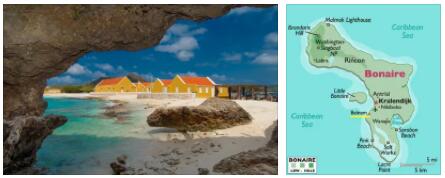Overview
The desert-like landscape of Bonaire, the second-largest island of the former Netherlands Antilles, is surrounded by turquoise-blue water and countless fish in all colors of the rainbow lure under the water surface between coral banks. Bonaire has the reputation of having the most beautiful diving and snorkeling areas in the entire Caribbean. Since tourism on Bonaire is only in its infancy, corals can develop here relatively undisturbed. The distinctively sloping position of the Divi Divi trees indicates that Bonaire’s warm, dry breezes are great for sailing and surfing. Bonaire is extremely eco-friendly, careful to protect the delicate coral ecosystem and not to spoil the island’s privacy with large hotel complexes and noisy nightlife. For these reasons, Bonaire’s sandy beaches and shallow, safe waters remain pristine. Flamingos roam undisturbed on the multicolored salt flats and countless bird species thrive in this natural paradise. See other countries in North America on physicscat.
Getting there
Arriving by plane
There are connections from Frankfurt, Zurich and Vienna to Bonaire via Amsterdam with KLM (KL) via Aruba. Non-stop from the USA fly at least once a week American Airlines (AA) from Miami, United (UA) from Houston and Newark and Delta (DL) from Atlanta to Bonaire. Sunwing (WG) offers non-stop service from Toronto.
Flight times
Frankfurt/M. – Bonaire: 14 hrs 20 mins; Zurich – Bonaire: 15 hrs 15 mins; Vienna – Bonaire: 15 hrs 10 mins
Departure fee
€30 This does not apply to children under the age of 2 (no own seat), passengers in transit (within 24 hours) and travelers who have already paid the fee at another airport in the Netherlands Antilles within 24 hours.
Arrival by ship
Kralendijk is Bonaire’s port, which is served by various cruise companies.
Cruise ships
Shipping companies such as Norwegian, P&O Cruises and AIDA have Kralendijk on their Caribbean cruises.
Transportation
Traveling by car/bus
The island’s road network is geared towards Kralendijk. From there, roads lead south and north along the coast, as well as into the interior of the island.
Right-hand traffic/left-hand traffic
Right
Condition of the roads
The island’s busy roads are paved. In more remote areas, however, travelers should always expect potholes and bottlenecks. Caution is advised, especially after dark, as there are sometimes animals on the road.
Car rental
Various rental car companies have offices in the hotels, at the airport and in Kralendijk. Jeeps are recommended for longer trips, especially for trips into Washington National Park. Minimum age for drivers: 21-26 years (depending on the requirements of the individual rental company).
Taxi
Taxis operate throughout the island, and their fares are set and controlled by the government. Between 19:00 and 24:00 a 25% surcharge applies, between 24:00 and 06:00 50%. A list of taxi prices is available from the Tourist Office (see addresses).
Bicycle
Bicycles and mopeds can be rented.
Coach
Minibuses and coaches travel across the island from Kralendijk.
Regulations
Traffic regulations: – right-hand traffic; – alcohol limit: 0.5 ‰; Novice drivers in the first 5 years: 0.2 ‰. Speed limits: – in built-up areas: 40 km/h; – extra-urban: 80 km/h.
Documentation
The national driving license is sufficient.
Traveling by ship
Water Taxi Kantika offers catamaran boat crossings to Klein Bonaire several times a day.
